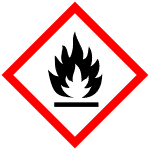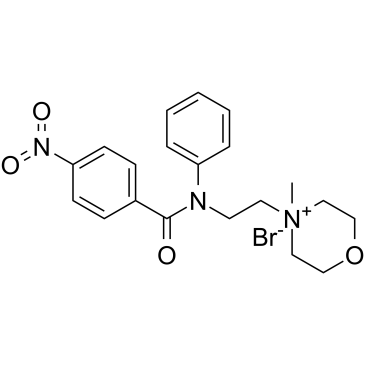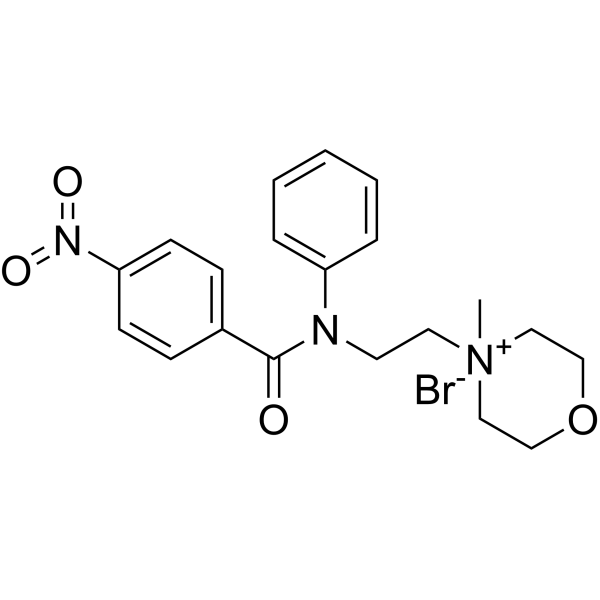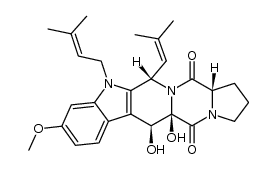疣孢青霉原, ≥98%,Selective K Ca 1.1 channel blocker
产品编号:西域试剂-WR380711| CAS NO:12771-72-1| 分子式:C27H33N3O7| 分子量:511.57
Verruculogen 是一种主要由青霉和曲霉属产生的毒素,在受感染的动物中引起严重震颤。Verruculogen 抑制 Ca2+ 激活的 K+ 通道。Verruculogen 是哺乳动物细胞周期的 M 期抑制剂。
本网站销售的所有产品仅用于工业应用或者科学研究等非医疗目的,不可用于人类或动物的临床诊断或者治疗,非药用,非食用,
| 英文名称 | Selective K Ca 1.1 channel blocker |
|---|---|
| CAS编号 | 12771-72-1 |
| 产品描述 | Verruculogen 是一种主要由青霉和曲霉属产生的毒素,在受感染的动物中引起严重震颤。Verruculogen 抑制 Ca2+ 激活的 K+ 通道。Verruculogen 是哺乳动物细胞周期的 M 期抑制剂。 |
| 产品熔点 | 233ºC |
| 产品沸点 | 738.4±60.0 °C at 760 mmHg |
| 产品密度 | 1.5±0.1 g/cm3 |
| 产品闪点 | 400.3±32.9 °C |
| 精确质量 | 511.231842 |
| PSA | 112.01000 |
| LogP | 2.60 |
| 外观性状 | 白色粉末 |
| 蒸气压 | 0.0±2.6 mmHg at 25°C |
| 折射率 | 1.691 |
| 储存条件 | 2-8°C |
相关文档
化学品安全说明书(MSDS)
下载MSDS质检证书(COA)
相关产品
| 符号 |


GHS02, GHS07 |
|---|---|
| 信号词 | Danger |
| 危害声明 | H225-H302 + H312 + H332-H319 |
| 警示性声明 | P210-P280-P305 + P351 + P338 |
| 危害码 (欧洲) | T: Toxic; |
| 风险声明 (欧洲) | R23/24/25 |
| 安全声明 (欧洲) | 36/37/39-45 |
| 危险品运输编码 | UN 2811 6.1/PG 2 |
| WGK德国 | 3 |
| RTECS号 | JH4920000 |
| 海关编码 | 38220090 |
|
SECTION 1: Identification of the substance/mixture and of the company/undertaking Product identifiers Product name: Verruculogen solution REACH No.: A registration number is not available for this substance as the substance or its uses are exempted from registration, the annual tonnage does not require a registration or the registration is envisaged for a later registration deadline.
Relevant identified uses of the substance or mixture and uses advised against Identified uses: Laboratory chemicals, Manufacture of substances SECTION 2: Hazards identification Classification of the substance or mixture Classification according to Regulation (EC) No 1272/2008 Flammable liquids (Category 2), H225 Acute toxicity, Oral (Category 4), H302 Acute toxicity, Inhalation (Category 4), H332 Acute toxicity, Dermal (Category 4), H312 Eye irritation (Category 2), H319 For the full text of the H-Statements mentioned in this Section, see Section 16. Classification according to EU Directives 67/548/EEC or 1999/45/EC F Highly flammableR11 Xn HarmfulR20/21/22 Xi IrritantR36 For the full text of the R-phrases mentioned in this Section, see Section 16. Label elements Labelling according Regulation (EC) No 1272/2008 Pictogram Signal wordDanger Hazard statement(s) H225Highly flammable liquid and vapour. H302 + H312 + H332Harmful if swallowed, in contact with skin or if inhaled H319Causes serious eye irritation. Precautionary statement(s) P210Keep away from heat/sparks/open flames/hot surfaces. - No smoking. P280Wear protective gloves/ protective clothing. P305 + P351 + P338IF IN EYES: Rinse cautiously with water for several minutes. Remove contact lenses, if present and easy to do. Continue rinsing. Supplemental Hazardnone Statements According to European Directive 67/548/EEC as amended. Hazard symbol(s)F Highly flammable Xn Harmful R-phrase(s) R11Highly flammable. R20/21/22Harmful by inhalation, in contact with skin and if swallowed. R36Irritating to eyes. S-phrase(s) S16Keep away from sources of ignition - No smoking. S26In case of contact with eyes, rinse immediately with plenty of water and seek medical advice. S36/37Wear suitable protective clothing and gloves. Other hazards - none SECTION 3: Composition/information on ingredients Mixtures Molecular Weight: 511,57 g/mol Hazardous ingredients according to Regulation (EC) No 1272/2008 ComponentClassificationConcentration Acetonitrile CAS-No.75-05-8Flam. Liq. 2; Acute Tox. 4; Eye 50 - 100 % EC-No.200-835-2Irrit. 2; H225, H302 + H312 + Index-No.608-001-00-3H332, H319 Registration number01-2119471307-38-XXXX Verruculogen from Penicillium verruculosum CAS-No.12771-72-1Acute Tox. 3; H301, H311,10 - 20 % H331 Hazardous ingredients according to Directive 1999/45/EC ComponentClassificationConcentration Acetonitrile CAS-No.75-05-8F, Xn, R11 - R20/21/22 - R3650 - 100 % EC-No.200-835-2 Index-No.608-001-00-3 Registration number01-2119471307-38-XXXX Verruculogen from Penicillium verruculosum CAS-No.12771-72-1T, R23/24/2510 - 20 % For the full text of the H-Statements and R-Phrases mentioned in this Section, see Section 16 SECTION 4: First aid measures Description of first aid measures General advice Consult a physician. Show this safety data sheet to the doctor in attendance. If inhaled If breathed in, move person into fresh air. If not breathing, give artificial respiration. Consult a physician. In case of skin contact Wash off with soap and plenty of water. Consult a physician. In case of eye contact Rinse thoroughly with plenty of water for at least 15 minutes and consult a physician. If swallowed Do NOT induce vomiting. Never give anything by mouth to an unconscious person. Rinse mouth with water. Consult a physician. Most important symptoms and effects, both acute and delayed The most important known symptoms and effects are described in the labelling (see section 2.2) and/or in section 11 Indication of any immediate medical attention and special treatment needed no data available SECTION 5: Firefighting measures Extinguishing media Suitable extinguishing media Use water spray, alcohol-resistant foam, dry chemical or carbon dioxide. Special hazards arising from the substance or mixture Carbon oxides, nitrogen oxides (NOx) Advice for firefighters Wear self contained breathing apparatus for fire fighting if necessary. Further information Use water spray to cool unopened containers. SECTION 6: Accidental release measures Personal precautions, protective equipment and emergency procedures Use personal protective equipment. Avoid breathing vapours, mist or gas. Ensure adequate ventilation. Remove all sources of ignition. Evacuate personnel to safe areas. Beware of vapours accumulating to form explosive concentrations. Vapours can accumulate in low areas. For personal protection see section 8. Environmental precautions Prevent further leakage or spillage if safe to do so. Do not let product enter drains. Methods and materials for containment and cleaning up Contain spillage, and then collect with an electrically protected vacuum cleaner or by wet-brushing and place in container for disposal according to local regulations (see section 13). Reference to other sections For disposal see section 13. SECTION 7: Handling and storage Precautions for safe handling Avoid contact with skin and eyes. Avoid inhalation of vapour or mist. Keep away from sources of ignition - No smoking.Take measures to prevent the build up of electrostatic charge. For precautions see section 2.2. Conditions for safe storage, including any incompatibilities Store in cool place. Keep container tightly closed in a dry and well-ventilated place. Containers which are opened must be carefully resealed and kept upright to prevent leakage. Recommended storage temperature: -20 °C Specific end use(s) Apart from the uses mentioned in section 1.2 no other specific uses are stipulated SECTION 8: Exposure controls/personal protection Control parameters Components with workplace control parameters Exposure controls Appropriate engineering controls Handle in accordance with good industrial hygiene and safety practice. Wash hands before breaks and at the end of workday. Personal protective equipment Eye/face protection Face shield and safety glasses Use equipment for eye protection tested and approved under appropriate government standards such as NIOSH (US) or EN 166(EU). Skin protection Handle with gloves. Gloves must be inspected prior to use. Use proper glove removal technique (without touching glove's outer surface) to avoid skin contact with this product. Dispose of contaminated gloves after use in accordance with applicable laws and good laboratory practices. Wash and dry hands. The selected protective gloves have to satisfy the specifications of EU Directive 89/686/EEC and the standard EN 374 derived from it. Body Protection Complete suit protecting against chemicals, Flame retardant antistatic protective clothing, The type of protective equipment must be selected according to the concentration and amount of the dangerous substance at the specific workplace. Respiratory protection Where risk assessment shows air-purifying respirators are appropriate use a full-face respirator with multi-purpose combination (US) or type ABEK (EN 14387) respirator cartridges as a backup to engineering controls. If the respirator is the sole means of protection, use a full-face supplied air respirator. Use respirators and components tested and approved under appropriate government standards such as NIOSH (US) or CEN (EU). Control of environmental exposure Prevent further leakage or spillage if safe to do so. Do not let product enter drains. SECTION 9: Physical and chemical properties Information on basic physical and chemical properties a) AppearanceForm: liquid b) Odourno data available c) Odour Thresholdno data available d) pHno data available e) Melting point/freezingno data available point f) Initial boiling point and no data available boiling range g) Flash pointno data available h) Evapouration rateno data available i) Flammability (solid, gas) no data available j) Upper/lowerno data available flammability or explosive limits k) Vapour pressureno data available l) Vapour densityno data available m) Relative densityno data available n) Water solubilityno data available o) Partition coefficient: n- no data available octanol/water p) Auto-ignitionno data available temperature q) Decompositionno data available temperature r) Viscosityno data available s) Explosive propertiesno data available t) Oxidizing propertiesno data available Other safety information no data available SECTION 10: Stability and reactivity Reactivity no data available Chemical stability Stable under recommended storage conditions. Possibility of hazardous reactions no data available Conditions to avoid Heat, flames and sparks. Extremes of temperature and direct sunlight. Incompatible materials acids, Bases, Oxidizing agents, Reducing agents, Alkali metals Hazardous decomposition products In the event of fire: see section 5 SECTION 11: Toxicological information Information on toxicological effects Acute toxicity no data available Skin corrosion/irritation no data available Serious eye damage/eye irritation no data available Respiratory or skin sensitisation no data available Germ cell mutagenicity no data available Carcinogenicity IARC:No component of this product present at levels greater than or equal to 0.1% is identified as probable, possible or confirmed human carcinogen by IARC. Reproductive toxicity no data available Specific target organ toxicity - single exposure no data available Specific target organ toxicity - repeated exposure no data available Aspiration hazard no data available Additional Information RTECS: Not available SECTION 12: Ecological information Toxicity no data available Persistence and degradability no data available Bioaccumulative potential no data available Mobility in soil no data available Results of PBT and vPvB assessment PBT/vPvB assessment not available as chemical safety assessment not required/not conducted Other adverse effects no data available SECTION 13: Disposal considerations Waste treatment methods Product Burn in a chemical incinerator equipped with an afterburner and scrubber but exert extra care in igniting as this material is highly flammable. Offer surplus and non-recyclable solutions to a licensed disposal company. Contaminated packaging Dispose of as unused product. SECTION 14: Transport information UN number ADR/RID: 1648IMDG: 1648IATA: 1648 UN proper shipping name ADR/RID: ACETONITRILE, SOLUTION IMDG: ACETONITRILE, SOLUTION IATA:Acetonitrile, SOLUTION Transport hazard class(es) ADR/RID: 3IMDG: 3IATA: 3 Packaging group ADR/RID: IIIMDG: IIIATA: II Environmental hazards ADR/RID: noIMDG Marine pollutant: noIATA: no Special precautions for user no data available SECTION 15: Regulatory information This safety datasheet complies with the requirements of Regulation (EC) No. 1907/2006. Safety, health and environmental regulations/legislation specific for the substance or mixture no data available Chemical Safety Assessment For this product a chemical safety assessment was not carried out SECTION 16: Other information Full text of H-Statements referred to under sections 2 and 3. Acute Tox.Acute toxicity Eye Irrit.Eye irritation Flam. Liq.Flammable liquids H225Highly flammable liquid and vapour. H301Toxic if swallowed. H302Harmful if swallowed. H302 + H312 +Harmful if swallowed, in contact with skin or if inhaled H332 H311Toxic in contact with skin. H312Harmful in contact with skin. H319Causes serious eye irritation. H331Toxic if inhaled. H332Harmful if inhaled. Full text of R-phrases referred to under sections 2 and 3 FHighly flammable TToxic R11Highly flammable. R20/21/22Harmful by inhalation, in contact with skin and if swallowed. R23/24/25Toxic by inhalation, in contact with skin and if swallowed. R36Irritating to eyes. XnHarmful Further information Copyright 2014 Co. LLC. License granted to make unlimited paper copies for internal use only. The above information is believed to be correct but does not purport to be all inclusive and shall be used only as a guide. The information in this document is based on the present state of our knowledge and is applicable to the product with regard to appropriate safety precautions. It does not represent any guarantee of the properties of the product. Corporation and its Affiliates shall not be held liable for any damage resulting from handling or from contact with the above product. See and/or the reverse side of invoice or packing slip for additional terms and conditions of sale. |
| 上游产品 1 | |
|---|---|
| 下游产品 0 | |










 浙公网安备 33010802013016号
浙公网安备 33010802013016号